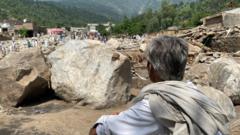A devastating wave of flash floods has swept through northern Pakistan, claiming the lives of at least 314 people and leaving 156 injured, primarily in Khyber Pakhtunkhwa province. The village of Bishnoi, which was once a picturesque community surrounded by lush mountains, now stands as a testament to nature's fury following a torrential downpour on August 15. Villagers awoke unaware of the disaster about to unfold as a powerful torrent of water surged through the area, sweeping away homes and livelihoods.
Witnesses recall the harrowing sight of giant rocks and debris crashing down, annihilating buildings in the flood's path. Rescue efforts have proven challenging, with locals and workers employing rudimentary tools to search for survivors beneath the rubble. Israr Khan, a villager, described the desperate situation: "There is a house under every stone. People try to look under these rocks to see if they can find someone."
The floods have left Buner district, where Bishnoi is located, as the hardest-hit area, with a staggering 217 fatalities reported. Many of the deceased were found in homes, where they had gathered to prepare for weddings. The Provincial Disaster Management Authority (PDMA) revealed that approximately 50% of the homes in Bishnoi were completely destroyed.
In South Asia, monsoon season is critical, as it brings about three-quarters of the annual rainfall. Unfortunately, heavy rains often lead to catastrophic flooding and landslides. This year alone, the toll from rain-related incidents has risen to over 507 deaths with still more weeks of monsoon ahead. While the northern regions, especially Khyber Pakhtunkhwa, face the most severe impact, other areas, including Punjab and Islamabad, have also been plagued by the deluge.
Experts attribute part of this increasing severity of flooding to climate change and the rapid retreat of glaciers in the region. These conditions exacerbate the likelihood of debris being dislodged, contributing to catastrophic flooding events. Authorities have warned that heavy rains are expected to continue, prompting disaster declarations in numerous regions.
Amidst the chaos, acts of heroism emerged. In the nearby Swat Valley, a school principal, Saeed Ahmad, successfully evacuated nearly 900 students just before floodwaters engulfed the school. His timely decision undoubtedly saved many lives. However, many families were not as fortunate. Abdul Salam, who lost his wife and children to the floods in Swat Valley, recounted the agonizing moments of trying to reach them.
In Buner, Asrar Khan anxiously awaits updates, as 27 villagers remain unaccounted for. He vividly recounted the swift devastation: "It all happened before my eyes," he said, grappling with the grief of those lost to the unforgiving waters.
As communities grapple with the aftermath, expeditions to rescue trapped individuals continue, though hopes for the missing wane. Relief agencies, including Al-Khidmat, are coordinating efforts to provide aid and medical assistance, while self-organized groups from surrounding areas lend support.
The streets of Buner tell a grim story, with crop fields flattened and debris overshadowing the landscape. The search for bodies continues as survivors struggle to comprehend their losses. As the relentless flooding serves as a stark reminder of climate vulnerabilities, the necessity for sustainable environmental efforts becomes increasingly urgent for the communities affected.



















